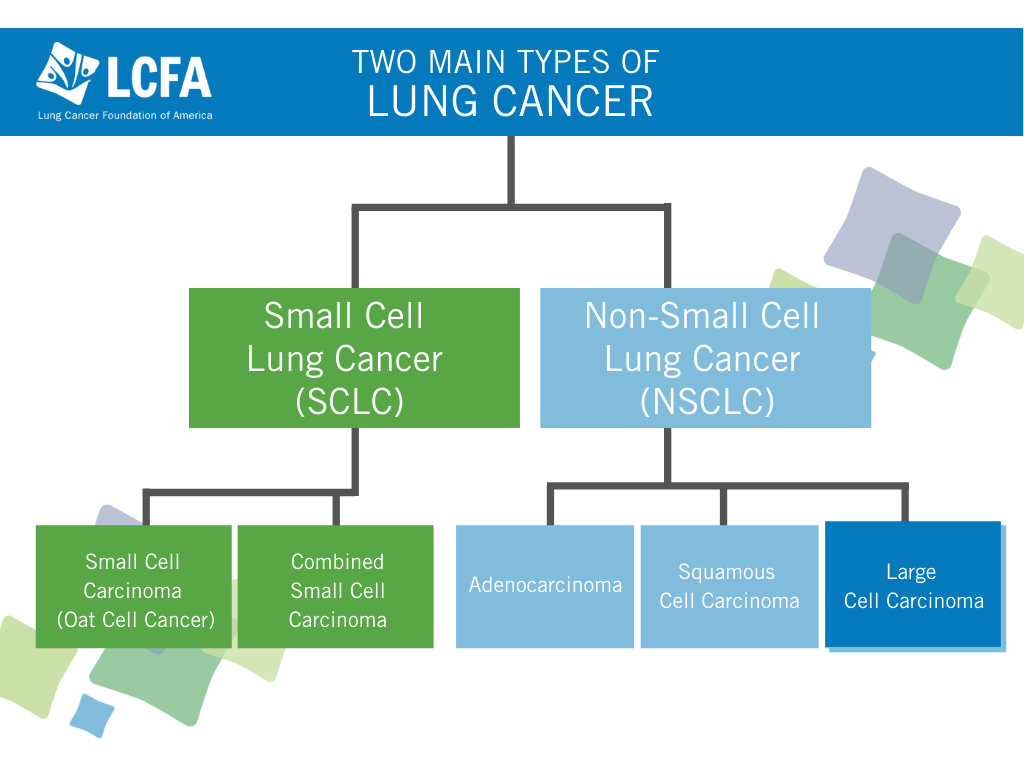About Lung Cancer | Diagnosis | Types
Large Cell Lung Cancer
What is Large Cell Lung Cancer?
There are two main types of lung cancer: small cell lung cancer and non-small cell lung cancer. Non-small cell lung cancer is further divided into three types:
- Adenocarcinoma, in which the cancer begins in glandular cells on the outer part of the lungs.
- Squamous cell carcinoma, in which the cancer begins in the thin, flat cells that line the airways.
- Large cell carcinoma, which begins in the cells that make up the outer lining of the lungs.
Large cell carcinoma is the least common type of lung cancer, and it accounts for about 1 in 10 cases of all lung cancers.
Large Cell vs. Small Cell Lung Cancer
While Large Cell Lung Carcinomas are a subtype of Non-Small Cell Lung Cancer, Small Cell Lung Cancer refers to a separate type of lung cancer, which has two of its own subtypes: Small Cell Carcinoma (Oat Cell Cancer) and Combined Small Cell Carcinoma. As their names suggest, under a microscope, the difference between Small Cell and Non-Small Cell Lung Cancer is their size – SCLC cells appear small and round, while NSCLC cells appear larger. Also, SCLC tends to be more aggressive and more difficult to treat than NSCLC.
Large Cell Carcinoma Diagnosis
A diagnosis of large cell carcinoma is usually made after a biopsy of the lung tissue. A biopsy is a procedure in which tissue samples are removed from the body so that they can be viewed under a microscope by a pathologist to check for cancer cells. The pathologist will look at the tissue under a microscope and check for cancer cells. The pathologist will also check for certain features that are typical of large cell carcinoma.

Stages of Large Cell Lung Cancer
- Stage 0: the cancer is found only in the top lining of the lung and has not spread outside the lung
- Stage I (IA and IB): the cancer has not spread to the lymph nodes or other parts of the body. The difference between each sub-stage is based on the size of the tumor and whether it has spread to the lung lining
- Stage II (IIA and IIB): the cancer is larger than Stage I and has begun to spread to nearby lymph nodes or tissues, but not to distant organs. The difference between each sub-stage is based on the size of the tumor, its location, and whether it has spread to the lymph nodes or not
- Stage III (IIIA, IIIB, and IIIC): the cancer may be difficult to remove via surgery. The difference between each sub-stage is based on the size of the tumor, its location, and how much it has spread
- Stage IV: the cancer has spread (metastasized) to other areas of the body outside the lungs
Symptoms
The symptoms of large cell carcinoma are similar to the symptoms of other types of lung cancer. And in many cases, symptoms are not apparent in the early stages of lung cancer. The most common symptoms of large cell carcinoma are:
- Cough
- Shortness of breath
- Chest pain
- Fever
- Weight loss
- Fatigue
- Night sweats
Treatment
The treatment of large cell carcinoma can be similar to other types of non-small cell lung cancer.
Surgery (wedge resection, lobectomy, or pneumonectomy)
Surgery is the most effective for combating large cell carcinoma when it is treated at an early stage. Wedge resection, lobectomy, or pneumonectomy may all be options for removing the lung tumor. In wedge resection, the tumor and a portion of the surrounding tissue is removed. A lobectomy removes the entire lobe of the lung. And a pneumonectomy removes the entire lung. (Most people can live with one lung as long as the remaining lung is healthy!)
Radiation Therapy or Chemotherapy
Radiation or Chemotherapy are two non-specific therapies that may be used together or separately to treat large cell carcinoma. Radiation or Chemotherapy could be used to shrink tumors prior to surgery, or after surgery to kill any remaining cancer cells. Radiation therapy is the practice of using high doses of radiation in order to kill cancer cells, while Chemotherapy uses drugs to kill cancer cells. However, these therapies can often kill healthy cells too, causing severe side effects, like hair loss.
Targeted Therapy
Targeted therapy is a type of treatment that detects specific features of the targeted cell, such as mutations or other characteristics, and disrupts the functioning of those specific cells – thus minimizing side effects of non-targeted, systemic treatments. There are several drugs being used to treat non-small cell lung cancers based on the tumors’ biomarkers. Make sure to request for biomarker testing to understand your best options for treatment.
Immunotherapy
Immunotherapy is a type of treatment that boosts the body’s natural immune response to combat cancer cells, thus circumventing side effects caused by systemic treatments like radiation and chemotherapy. There are several immunotherapy drugs now being used to treat non-small cell lung cancers.
